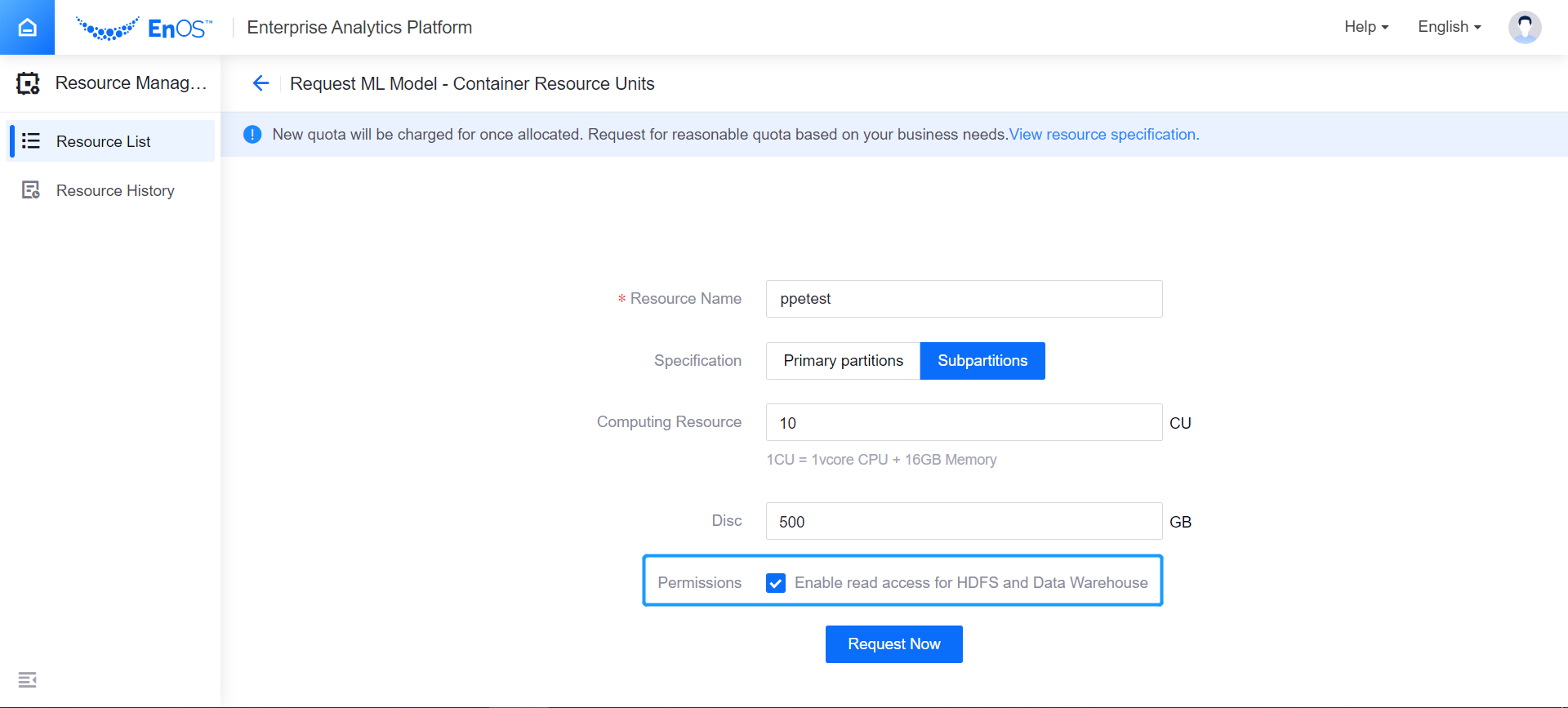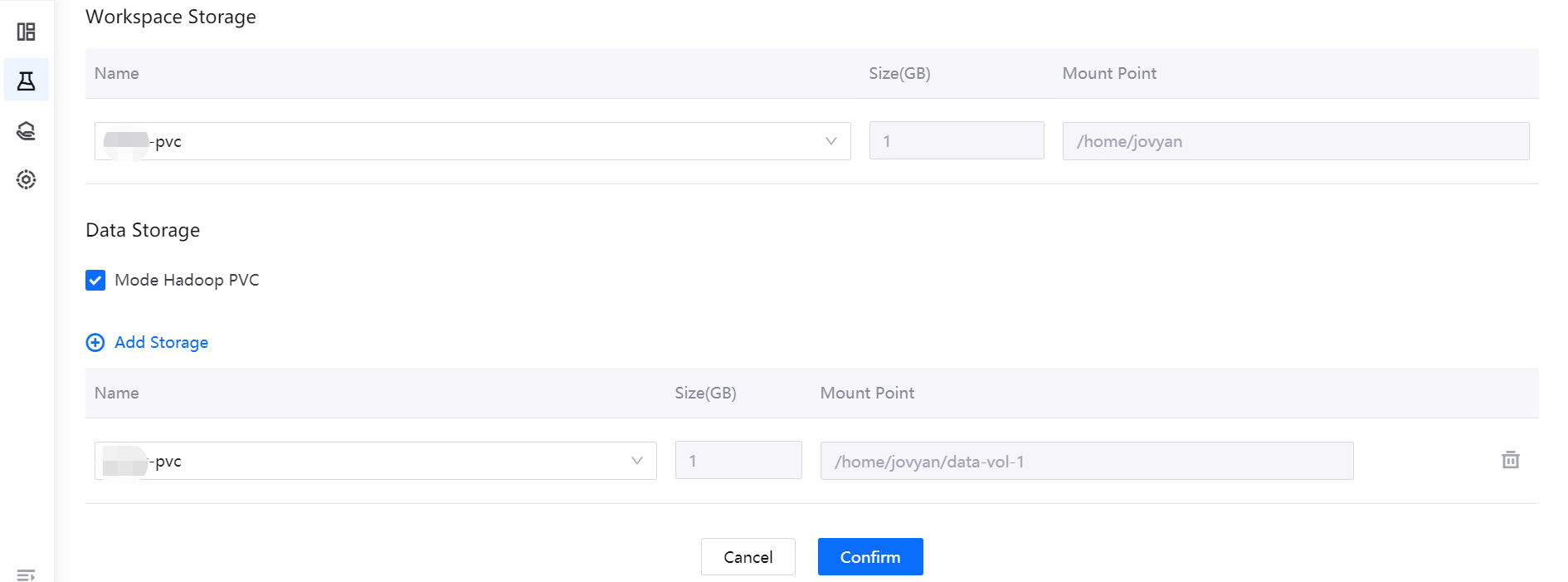Managing Notebook Instances¶
The MI Lab integrates Jupyter Notebook to provide a model development and researching environment for data scientists. After entering the MI Lab, you can perform the following management operations on the notebook instances:
View notebook instances
Create a notebook instance
Delete notebook instances
Open a notebook instance and enter the JupyterLab experiment environment
Prerequisites¶
The organization has requested the ML Model - Container resource required by the notebook instance (resource pool) through the EnOS Management Console > Resource Management page.
You have added the workspace storage and data storage required by the notebook instance through the Resource Configuration > Storage Configuration page.
The system administrator has uniformly produced standard notebook images, which can be used by the notebook.
Creating a Notebook Instance¶
The MI Lab notebook instance supports different types of resource pools (resource pools that enable or disable the data read access for HDFS and Data Warehouse). When creating a notebook instance, you can select different types of resource pools according to business needs.
Data Read Access Disabled for HDFS and Data Warehouse¶
You can create a notebook instance (without using HDFS and Data Warehouse) by following these steps:
Log in to the EnOS Management Console, and select Enterprise Analytics Platform > Machine Intelligence Studio > MI Lab from the left navigation bar to open the Notebook homepage.
Click New Instance to complete the basic information, iamge, and required resource configuration of the notebook instance:
Instance Name: enter the name of the notebook instance
Resource Pool: select the resource pool that has been requested in Resource Management to run the notebook instance
Image: select the image to be used by the notebook instance
CPU/Memory: enter the CPU and memory resources required for running the notebook instance
Workspace Storage: select the storage corresponding to the resource pool as the workspace storage required for the notebook instance to run
Data Storage: select the storage corresponding to the resource pool to store experimental data and specify the data mount point


Click OK. After the notebook instance is created, it will start running.

Data Read Access Enabled for HDFS and Data Warehouse¶
Prerequisites:
You should ensure that the organization has request the ML Model - Container resource through the Resource Management page, and the data read access for HDFS and Data Warehouses is enabled for the requested resources. As shown below:

You have used the requested resource pool to add the workspace storage and data storage required by the notebook instance through the Resource Configuration > Storage Configuration page. As shown below:

You can then create a notebook instance (with data read access enabled for HDFS and Data Warehouse) by following these steps:
Log in to the EnOS Management Console, and select Enterprise Analytics Platform > Machine Intelligence Studio > MI Lab from the left navigation bar to open the Notebook homepage.
Click New Instance to complete the basic information, mirroring, and required resource configuration of the notebook instance:
Instance Name: enter the name of the notebook instance
Resource Pool: select the resource pool that has been requested in Resource Management to run the notebook instance
Image: select the image to be used by the notebook instance (where only pyspark or spark images can be selected)
CPU/Memory: enter the CPU and memory resources required by the notebook instance to run
Workspace Storage: select the storage corresponding to the resource pool as the workspace storage required for the notebook instance to run
Data Storage: check Mount Hadoop PVC, and add the storage corresponding to the resource pool to store experimental data and specify the data mount point


Click OK. After the notebook instance is created, it will start running.

Opening the Notebook Instance and Entering JupyterLab¶
After the notebook instance starts running, click the Enter button in the notebook instance list to enter the JupyterLab environment and start data exploration and development.

For more information about how to use JupyterLab for data exploration and development, see JupyterLab Documentation.
Deleting Notebook Instance¶
When the notebook instance is no longer needed after the model experiment development is completed, you can select the notebook instance in the notebook instance list and click the Delete button to delete the notebook instance and release appropriate resources.
Note
Before deleting the notebook instance, you need to ensure that the files stored in the notebook are allowed to be deleted, and any deleted files cannot be restored. Please operate with caution.